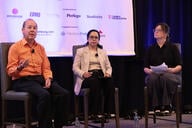You have /5 articles left.
Sign up for a free account or log in.

Online enrollments are seeing a drop post-COVID, according to new data.
BigNazik/iStock/Getty Images
The number of students participating in online learning is continuing a post-pandemic decline, new enrollment data show.
In the 2022–23 academic year, a little over half of U.S. students—53 percent—were enrolled in at least one online course, according to National Center for Education Statistics data released last week. That dipped from 2021’s fall enrollment, which counted 59 percent of students online in some way.
The decline was not unexpected given the surge of remote learning during the 2019–20 academic year, at the start of the COVID-19 pandemic.
Despite the gradual three-year decline, the popularity of online learning still stayed above pre-pandemic levels. In 2018–19, only 35 percent of students took online courses.
“It’s a continued sign of going mainstream,” said Richard Garrett, chief research officer at Eduventures. “Twenty-twenty was an aberration and, yes, online enrollment went down in ’21 and down again in ’22. If it went on the curve we were expecting, then I'd say COVID was just a wash, but these numbers show it as a net positive.”
The 2021–22 year was the first full year after the height of the pandemic, although many colleges—especially those in coastal states like New York and California—still pushed for hybrid learning.
Participation in online education in the most recent academic year fluctuated greatly depending on the university type, according to the data.
Private colleges and universities saw the biggest variation. Private, nonprofit institutions had roughly a quarter of their students enrolled exclusively in online courses, a number that has always been relatively low. From 2018 through 2020, no more than 26 percent of private, nonprofit students partook solely in online courses.
Meanwhile, private for-profit institutions had 52 percent of students exclusively enrolled in online courses in the most recent academic year—a number that has remained steady over the last five years.
It's not realistic to think online is their savior.”
—Richard Garrett, chief research officer at Eduventures
At public institutions, student enrollment divided roughly into thirds across those who took all online courses, some online courses or none at all. Among graduate students at public institutions, the proportion of those going entirely in person was higher at 46 percent.
James Wiley at ListEdTech, an education-focused market research firm, noted the dips in both students exclusively taking online courses and those enrolled in a mix of online and face-to-face courses.
“I would have thought that any decrease in those exclusively enrolled online would be offset by increases in enrolling in some—but not all—distance education courses,” said Wiley, a VP of product and research. “But we’re seeing those that were exclusively in online courses are going to the other end of the spectrum, to entirely in-person courses.”
The National Center for Education Statistics has tracked enrollment in online education since the 2013–14 academic year, pulling from its annual Integrated Postsecondary Education Data System (IPEDS).
The IPEDS data show a contrast with other reports that have predicted growing demand for online enrollment. Expecting this demand, many universities have focused on bolstering their online offerings. According to a 2023 “Changing Landscape of Online Education” report, two-thirds of institutions are adding online programs.
Garrett of Eduventures, despite being a strong advocate for online courses, said universities—especially those in financial turmoil—need to consider if online is their best course of action.
“Most of them, even if they can get a bit of online tailwind by going from nothing to something, are going to struggle unless they can offer something special,” he said. “It’s not realistic to think online is their savior unless they have some super-niche offering [that] unlocks demands that couldn’t be realized otherwise.”
Wiley suggested universities need to view online offerings cautiously.
“The future is much more uncertain given this data,” Wiley said. “This should give institutions pause to say, ‘Maybe I shouldn’t put all my eggs in this basket,’ or to find out why [online enrollment is dropping]—whether it’s the quality or it’s something else.”





